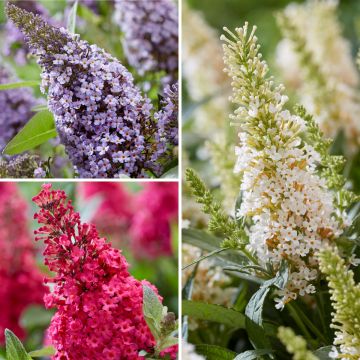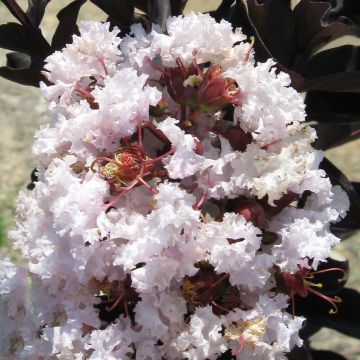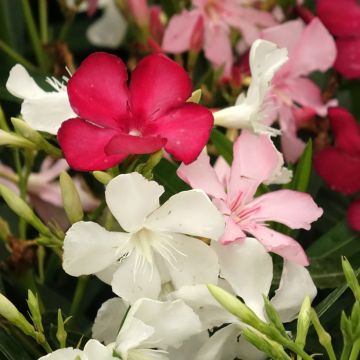

Buddleia Butterfly Tower White - Butterfly Bush


Buddleia Butterfly Tower White - Butterfly Bush
Buddleia Butterfly Tower White - Butterfly Bush
Buddleja x davidii Flower Tower® White
Butterfly Bush, Summer Lilac
Special offer!
Receive a €20 voucher for any order over €90 (excluding delivery costs, credit notes, and plastic-free options)!
1- Add your favorite plants to your cart.
2- Once you have reached €90, confirm your order (you can even choose the delivery date!).
3- As soon as your order is shipped, you will receive an email containing your voucher code, valid for 3 months (90 days).
Your voucher is unique and can only be used once, for any order with a minimum value of €20, excluding delivery costs.
Can be combined with other current offers, non-divisible and non-refundable.
Why not try an alternative variety in stock?
View all →This plant carries a 24 months recovery warranty
More information
We guarantee the quality of our plants for a full growing cycle, and will replace at our expense any plant that fails to recover under normal climatic and planting conditions.
Would this plant suit my garden?
Set up your Plantfit profile →
Description
The Buddleia Butterfly Tower 'White', with its white flowering, is a recent selection of bush that is quite revolutionary due to its narrow habit, in a tight column. Deciduous, it adorns itself in spring with delicate foliage and transforms in summer into an elegant flowering tower of white panicles, highly visited by butterflies. Growing this shrub poses no difficulty in ordinary soil, even poor and occasionally dry, and its modest size is suitable for gardens of all sizes.
The Buddleia davidii Butterfly Tower 'White' is a deciduous bush, which usually loses its foliage in winter. It belongs to the family of Scrophulariaceae. This amazing British cultivar, recently obtained by Thompson & Morgan, is derived from the David's buddleia, also known as the Father David's buddleia or the Changing buddleia. The latter is a robust Chinese species that has become invasive in our climate. 'Butterfly Tower 'White' is a hybrid that does not self-seed in the garden or in nature.
The bush has a narrow, dense habit, supported by short and barely arching branches. It reaches an average height of 2m with a spread of 1m within 7 or 8 years, depending on the growing conditions. It flowers from July to early September, producing an abundance of 20 to 25cm long flower panicles. The flowers are white. They release a sweet, sugary fragrance, highly attractive to pollinators. The ornamental foliage of this butterfly bush is composed of fine, rather small leaves, of a deep green colour, with a greyish down on the underside. This very hardy shrub withstands urban pollution and does not suffer from occasional drought in deep soil.
The Buddleia davidii 'Butterfly Tower White' brings a unique touch of elegance to the garden, whether planted alone, in groups, forming a hedge, placed at the corner of a terrace, or at the back of a perennial bed. Its inflorescences, visited by multicoloured butterflies, offer a true visual spectacle. They harmonise with the mauve and white panicles of some summer lilacs. The Buddleia 'Butterfly Tower White' also fits well in a free hedge composed of botanical roses, serviceberries, hawthorns, Japanese quinces, and forsythias, thus extending the flowering period. Suitable for coastal and container cultivation, this buddleia offers fragrant flowers that also enhance bouquets. For an elegant contrast, associate it with tall grasses such as Miscanthus, Panicum, and Deschampsia.
Plant habit
Flowering
Foliage
Botanical data
Buddleja
x davidii
Flower Tower® White
Buddlejaceae
Butterfly Bush, Summer Lilac
Buddleia davidii ‘TMBU08/3’ PPAF
Cultivar or hybrid
Other Buddleja -Butterfly bush
View all →Planting and care
The 'Butterfly Tower White' Buddleia is easy to grow, as it is a low-maintenance plant that adapts to a wide range of soils and climates. It thrives in sunny locations but also flowers in partial shade. Plant it in spring or early autumn, in ordinary soil, even if it is limestone and poor, but well-worked and well-drained. Once established, the plant can withstand periods of moderate drought, especially if planted in deep soil. The buddleia has no significant enemies. However, be wary of caterpillars, weevils, bugs, and red spiders that may invade it. Pruning vigorously after flowering and/or in early spring maintains the bush's ramified and compact habit and encourages it to produce numerous flowers.
Planting period
Intended location
Care
Planting & care advice
This item has not been reviewed yet - be the first to leave a review about it.
Similar products
Haven't found what you were looking for?
Hardiness is the lowest winter temperature a plant can endure without suffering serious damage or even dying. However, hardiness is affected by location (a sheltered area, such as a patio), protection (winter cover) and soil type (hardiness is improved by well-drained soil).

Photo Sharing Terms & Conditions
In order to encourage gardeners to interact and share their experiences, Promesse de fleurs offers various media enabling content to be uploaded onto its Site - in particular via the ‘Photo sharing’ module.
The User agrees to refrain from:
- Posting any content that is illegal, prejudicial, insulting, racist, inciteful to hatred, revisionist, contrary to public decency, that infringes on privacy or on the privacy rights of third parties, in particular the publicity rights of persons and goods, intellectual property rights, or the right to privacy.
- Submitting content on behalf of a third party;
- Impersonate the identity of a third party and/or publish any personal information about a third party;
In general, the User undertakes to refrain from any unethical behaviour.
All Content (in particular text, comments, files, images, photos, videos, creative works, etc.), which may be subject to property or intellectual property rights, image or other private rights, shall remain the property of the User, subject to the limited rights granted by the terms of the licence granted by Promesse de fleurs as stated below. Users are at liberty to publish or not to publish such Content on the Site, notably via the ‘Photo Sharing’ facility, and accept that this Content shall be made public and freely accessible, notably on the Internet.
Users further acknowledge, undertake to have ,and guarantee that they hold all necessary rights and permissions to publish such material on the Site, in particular with regard to the legislation in force pertaining to any privacy, property, intellectual property, image, or contractual rights, or rights of any other nature. By publishing such Content on the Site, Users acknowledge accepting full liability as publishers of the Content within the meaning of the law, and grant Promesse de fleurs, free of charge, an inclusive, worldwide licence for the said Content for the entire duration of its publication, including all reproduction, representation, up/downloading, displaying, performing, transmission, and storage rights.
Users also grant permission for their name to be linked to the Content and accept that this link may not always be made available.
By engaging in posting material, Users consent to their Content becoming automatically accessible on the Internet, in particular on other sites and/or blogs and/or web pages of the Promesse de fleurs site, including in particular social pages and the Promesse de fleurs catalogue.
Users may secure the removal of entrusted content free of charge by issuing a simple request via our contact form.
The flowering period indicated on our website applies to countries and regions located in USDA zone 8 (France, the United Kingdom, Ireland, the Netherlands, etc.)
It will vary according to where you live:
- In zones 9 to 10 (Italy, Spain, Greece, etc.), flowering will occur about 2 to 4 weeks earlier.
- In zones 6 to 7 (Germany, Poland, Slovenia, and lower mountainous regions), flowering will be delayed by 2 to 3 weeks.
- In zone 5 (Central Europe, Scandinavia), blooming will be delayed by 3 to 5 weeks.
In temperate climates, pruning of spring-flowering shrubs (forsythia, spireas, etc.) should be done just after flowering.
Pruning of summer-flowering shrubs (Indian Lilac, Perovskia, etc.) can be done in winter or spring.
In cold regions as well as with frost-sensitive plants, avoid pruning too early when severe frosts may still occur.
The planting period indicated on our website applies to countries and regions located in USDA zone 8 (France, United Kingdom, Ireland, Netherlands).
It will vary according to where you live:
- In Mediterranean zones (Marseille, Madrid, Milan, etc.), autumn and winter are the best planting periods.
- In continental zones (Strasbourg, Munich, Vienna, etc.), delay planting by 2 to 3 weeks in spring and bring it forward by 2 to 4 weeks in autumn.
- In mountainous regions (the Alps, Pyrenees, Carpathians, etc.), it is best to plant in late spring (May-June) or late summer (August-September).
The harvesting period indicated on our website applies to countries and regions in USDA zone 8 (France, England, Ireland, the Netherlands).
In colder areas (Scandinavia, Poland, Austria...) fruit and vegetable harvests are likely to be delayed by 3-4 weeks.
In warmer areas (Italy, Spain, Greece, etc.), harvesting will probably take place earlier, depending on weather conditions.
The sowing periods indicated on our website apply to countries and regions within USDA Zone 8 (France, UK, Ireland, Netherlands).
In colder areas (Scandinavia, Poland, Austria...), delay any outdoor sowing by 3-4 weeks, or sow under glass.
In warmer climes (Italy, Spain, Greece, etc.), bring outdoor sowing forward by a few weeks.




































































